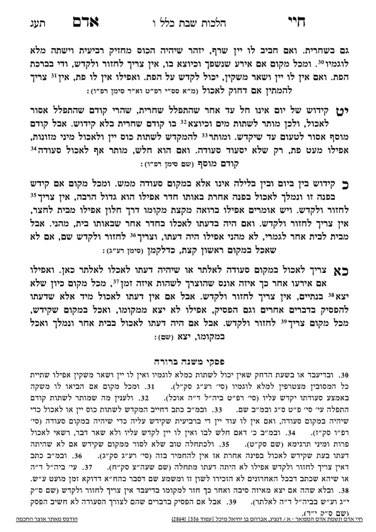The current series, which will cover Maariv on Friday night and Kiddush, is available for sponsorship. Please contact Rabbi Reingold for more information.
We are beginning siman 21, where the Chayei Adam continues the halachos of kiddush b’mokom seuda. The Chayei Adam writes that there should not be a time lapse between making kiddush and the seudah. However, if one planned to eat immediately after making kiddush, and something came up and stopped them from doing so, it is also valid, assuming they did not leave the place. If he left the place, it would be a problem. For example, if a neighbor knocks between kiddush and making hamotzi and asks for help, if one leaves their home and goes with the neighbor, it would be a problem. On the other hand, if the neighbor asks for an item, and it takes a few extra minutes to find it, as long as he does not leave the house, it is still considered kiddush b’mokom seudah, because he had planned to eat right away.
The Chayei Adam uses the words that if the person ends up waiting “a little bit (eizeh zman)”, as long as they did not leave the place, it is still considered kiddush b’mokom seudah. The implication is that if one waits a “long time”, even if they remain in the same place, it would be a problem. It is not clear from the Chayei Adam the definition of these times.
The Chayei Adam continues, and writes that if a person makes kiddush with the intention that they are not immediately beginning their seudah, and they did have a time lapse, they would have to repeat kiddush. The Mishnah Berurah points out that if the intention behind the time lapse was to take care of things for the seudah, it is muttar bedieved.
However, if a person planned to make kiddush and eat right away in a different house, even though doing so would require a new kiddush in the second place, if they changed their minds and ended up eating in the first place, they are yotzei. This case is different from the previous case because the problematic intent, to eat elsewhere, never happened. But here, the problematic intent was to have a break in between the kiddush and the seudah, and it happened.
Similarly, if one makes kiddush with intent to eat just a little later (e.g. 15 minutes), but then realizes they should eat immediately, according to the Chayei Adam it would seem that they would be yotzei bedieved, because the problematic intent didn’t come to fruition.
We see from the Chayei Adam the importance of avoiding a time lapse between kiddush and the seudah. Regarding the definition of a seudah, we will learn in the next siman that seudah can include eating mezonos or even just wine. Thus, if one makes kiddush and does not plan to eat their Shabbos meal immediately, they can be yotzei kiddush b’mokom seudah with mezonos or wine and it is acceptable. Otherwise, they are not yotzei and must repeat kiddush when they are ready to begin their seudah.
Summary
There should not be a time lapse between making kiddush and beginning the seudah. Bedieved, as long as one did not intend for a large time lapse, a small time lapse is muttar.



